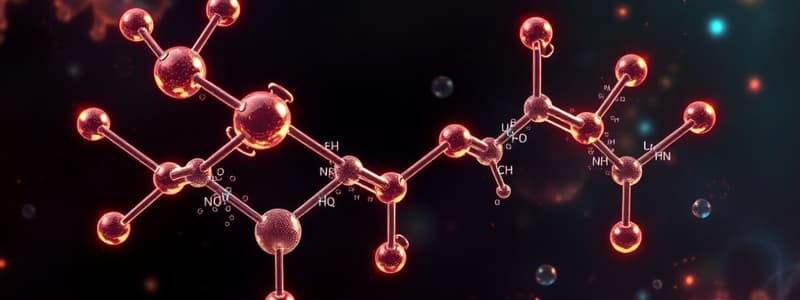Podcast
Questions and Answers
Which carbonyl compound requires Lithium aluminium hydride (LiAlH4) for reduction?
Which carbonyl compound requires Lithium aluminium hydride (LiAlH4) for reduction?
- Carboxylic acid (correct)
- Secondary alcohol
- Ketone
- Aldehyde
Which property of alcohols is primarily responsible for their unusually high boiling points?
Which property of alcohols is primarily responsible for their unusually high boiling points?
- Weak Van der Waals forces between molecules
- Ionic interactions
- Covalent bonds within molecules
- Hydrogen bonding between molecules (correct)
What is produced when an aldehyde is fully reduced?
What is produced when an aldehyde is fully reduced?
- Carboxylic acid
- Primary alcohol (correct)
- Secondary alcohol
- Ketone
What property distinguishes phenols from aliphatic alcohols?
What property distinguishes phenols from aliphatic alcohols?
How does the acidity of alcohols change with the increase in alkyl substitution?
How does the acidity of alcohols change with the increase in alkyl substitution?
What do sodium borohydride (NaBH4) and lithium aluminium hydride (LiAlH4) provide during the reduction of carbonyl compounds?
What do sodium borohydride (NaBH4) and lithium aluminium hydride (LiAlH4) provide during the reduction of carbonyl compounds?
What effect does hydrogen bonding have on phenol compared to similar sized compounds?
What effect does hydrogen bonding have on phenol compared to similar sized compounds?
What is the approximate pKa range for standard alcohols?
What is the approximate pKa range for standard alcohols?
Why are phenols more acidic than aliphatic alcohols?
Why are phenols more acidic than aliphatic alcohols?
What is produced as a byproduct during Fischer Esterification?
What is produced as a byproduct during Fischer Esterification?
What role does H2SO4 play in the ester formation process?
What role does H2SO4 play in the ester formation process?
Which enzyme converts alcohol to aldehyde in biological oxidation?
Which enzyme converts alcohol to aldehyde in biological oxidation?
What is the characteristic of the reaction where hydroxyl groups are replaced by halogens?
What is the characteristic of the reaction where hydroxyl groups are replaced by halogens?
What is the result of the biological oxidation of aldehydes?
What is the result of the biological oxidation of aldehydes?
How do high oxidation state metal salts function in chemical reactions?
How do high oxidation state metal salts function in chemical reactions?
What happens to esters when they undergo hydrolysis in the presence of aqueous acid?
What happens to esters when they undergo hydrolysis in the presence of aqueous acid?
Which compound can inhibit the second step of biological oxidation of alcohols?
Which compound can inhibit the second step of biological oxidation of alcohols?
What characterizes the C-X bond in haloalkanes?
What characterizes the C-X bond in haloalkanes?
Which property significantly increases the boiling point of haloalkanes compared to alkanes?
Which property significantly increases the boiling point of haloalkanes compared to alkanes?
What is the main reason that haloalkanes are able to act as electrophiles?
What is the main reason that haloalkanes are able to act as electrophiles?
Which of the following compounds is primarily used as a general anaesthetic?
Which of the following compounds is primarily used as a general anaesthetic?
How do di- and polyhalogenated alkanes compare to water?
How do di- and polyhalogenated alkanes compare to water?
Which reaction pathway is typically followed by nucleophilic substitution in alkyl halides?
Which reaction pathway is typically followed by nucleophilic substitution in alkyl halides?
What is the effect of halogen atoms on the freezing point of liquid haloalkanes?
What is the effect of halogen atoms on the freezing point of liquid haloalkanes?
What causes the greater density of haloalkanes compared to alkanes of similar size?
What causes the greater density of haloalkanes compared to alkanes of similar size?
Which of the following mechanisms involves the direct replacement of a halide by a nucleophile?
Which of the following mechanisms involves the direct replacement of a halide by a nucleophile?
Which statement about diethyl ether is true?
Which statement about diethyl ether is true?
Flashcards
What makes phenols unique?
What makes phenols unique?
Phenols are planar molecules with a shorter C-O bond distance compared to aliphatic alcohols, making them more reactive. They have a special type of hydrogen bonding that makes them more soluble in water than other molecules of similar size.
How do H-bonds affect phenol properties?
How do H-bonds affect phenol properties?
Phenols have a higher melting and boiling point than aliphatic alcohols because of their ability to form stronger hydrogen bonds with other phenol molecules and with water.
Why are phenols more acidic?
Why are phenols more acidic?
Phenols are more acidic than aliphatic alcohols because the phenoxide ion is stabilized by resonance, making it easier to lose a hydrogen ion.
What is epinephrine and its role?
What is epinephrine and its role?
Signup and view all the flashcards
How is epinephrine synthesized?
How is epinephrine synthesized?
Signup and view all the flashcards
Fischer Esterification
Fischer Esterification
Signup and view all the flashcards
Oxidation
Oxidation
Signup and view all the flashcards
What is an aldehyde?
What is an aldehyde?
Signup and view all the flashcards
What is a ketone?
What is a ketone?
Signup and view all the flashcards
Alcohol Dehydrogenase
Alcohol Dehydrogenase
Signup and view all the flashcards
What is a carboxylic acid?
What is a carboxylic acid?
Signup and view all the flashcards
Reaction of Alcohols with HX
Reaction of Alcohols with HX
Signup and view all the flashcards
Oxidation
Oxidation
Signup and view all the flashcards
What is an ester?
What is an ester?
Signup and view all the flashcards
What is reduction in organic chemistry?
What is reduction in organic chemistry?
Signup and view all the flashcards
Biological Oxidation of Alcohols
Biological Oxidation of Alcohols
Signup and view all the flashcards
Reduction
Reduction
Signup and view all the flashcards
What can be prepared by reducing carbonyl compounds?
What can be prepared by reducing carbonyl compounds?
Signup and view all the flashcards
Haloalkane (Alkyl Halide)
Haloalkane (Alkyl Halide)
Signup and view all the flashcards
What is sodium borohydride (NaBH4)?
What is sodium borohydride (NaBH4)?
Signup and view all the flashcards
What is lithium aluminum hydride (LiAlH4)?
What is lithium aluminum hydride (LiAlH4)?
Signup and view all the flashcards
What is alkoxide formation?
What is alkoxide formation?
Signup and view all the flashcards
How do alcohols react with oxygen?
How do alcohols react with oxygen?
Signup and view all the flashcards
What are alcohols?
What are alcohols?
Signup and view all the flashcards
Why do alcohols have higher boiling points?
Why do alcohols have higher boiling points?
Signup and view all the flashcards
What is the acidity of alcohols?
What is the acidity of alcohols?
Signup and view all the flashcards
How do substituents affect alcohol acidity?
How do substituents affect alcohol acidity?
Signup and view all the flashcards
What are phenols?
What are phenols?
Signup and view all the flashcards
What are the dangers of methanol?
What are the dangers of methanol?
Signup and view all the flashcards
What is ethanol?
What is ethanol?
Signup and view all the flashcards
What are the main methods for preparing alcohols?
What are the main methods for preparing alcohols?
Signup and view all the flashcards
Describe the hydration of alkenes to prepare alcohols.
Describe the hydration of alkenes to prepare alcohols.
Signup and view all the flashcards
Describe the hydrolysis of alkyl halides to prepare alcohols.
Describe the hydrolysis of alkyl halides to prepare alcohols.
Signup and view all the flashcards
Describe the reduction of carbonyl compounds to prepare alcohols.
Describe the reduction of carbonyl compounds to prepare alcohols.
Signup and view all the flashcards
What is nucleophilic substitution and its relevance to alcohols?
What is nucleophilic substitution and its relevance to alcohols?
Signup and view all the flashcards
What factors influence the reactivity of alcohols and alkyl halides in nucleophilic substitution?
What factors influence the reactivity of alcohols and alkyl halides in nucleophilic substitution?
Signup and view all the flashcards
What types of reactions can alcohols undergo?
What types of reactions can alcohols undergo?
Signup and view all the flashcards
What are haloalkanes?
What are haloalkanes?
Signup and view all the flashcards
How are haloalkanes reactive?
How are haloalkanes reactive?
Signup and view all the flashcards
What is the role of haloalkanes in medicine?
What is the role of haloalkanes in medicine?
Signup and view all the flashcards
How do haloalkanes differ from alkanes in terms of boiling points?
How do haloalkanes differ from alkanes in terms of boiling points?
Signup and view all the flashcards
Compare the densities of haloalkanes and hydrocarbons.
Compare the densities of haloalkanes and hydrocarbons.
Signup and view all the flashcards
How are haloalkanes prepared?
How are haloalkanes prepared?
Signup and view all the flashcards
What is the main type of reaction for haloalkanes?
What is the main type of reaction for haloalkanes?
Signup and view all the flashcards
Why are haloalkanes prone to nucleophilic substitution?
Why are haloalkanes prone to nucleophilic substitution?
Signup and view all the flashcards
What are some applications of haloalkanes?
What are some applications of haloalkanes?
Signup and view all the flashcards
How are haloalkanes used in agriculture?
How are haloalkanes used in agriculture?
Signup and view all the flashcards
Study Notes
MPharm Programme - PHA111 Functional Group Chemistry 3
- Learning Objectives:
- Describe and explain differences in physical properties of aliphatic alcohols, phenols, and haloalkanes based on structure and intermolecular interactions.
- List reactions to prepare alcohols, and reactions alcohols can undergo, including relevant reagents and conditions.
- Understand reactivity of alcohols and alkyl halides regarding nucleophilic substitution reactions.
Alcohols: General Properties
- Alcohols are unsaturated or saturated compounds containing C-O-H single bonds.
- Hydroxyl/alcohol is a functional group.
- Oxygen is sp³ hybridized, similar to water, with lone pairs to donate.
- Act as nucleophiles.
- Reactivity controlled by the electron-rich oxygen atom.
- pK range: 15.5-18.0 (phenols ~10).
- Sub-classified as primary (1°), secondary (2°), and tertiary (3°).
Alcohols: pKa
- pK range: 15.5-18.0.
- Acidity decreases with increased alkyl substitution (positive inductive effect).
- Alkyl groups are electron-donating.
- Acidity increases with halogen substituents (negative inductive effect).
- Halogens are electron-withdrawing.
- pKa depends on neighboring groups/substituents ability to stabilize (or destabilize) the resulting negative charge.
- Phenol is significantly more acidic (100 million times) than cyclohexanol.
- Negative charge is stabilized by resonance.
Alcohols: pKa values (Table)
- Specific pKa values for various alcohols are provided in a table, including methanol, ethanol, 2-chloroethanol, etc., and compared to water and other acids (e.g. acetic acid, hydrochloric acid).
Alcohols: Physical Properties
- Similar increases in melting/boiling points across homologous series.
- Unusual high boiling points due to hydrogen bonding between molecules.
- Small alcohols are miscible with water, but solubility decreases with increasing alkyl group size.
- Like dissolves like. Specific examples and their solubility in water are listed in a table.
Alcohols: Preparation
- Methanol: Prepared by reacting CO and H2 at high temperature with a zinc oxide/chromia catalyst. Toxic dose: 100 mL.
- Ethanol: Industrially produced via fermentation of starch and grains. Toxic dose: 200 mL.
- More complex alcohols prepared using three main methods: hydration of alkenes, hydrolysis of alkyl halides, and reduction of carbonyl compounds (e.g., aldehydes, ketones, carboxylic acids, and esters).
Reduction of Carbonyl Compounds
- Alcohols can be prepared through the reduction of various carbonyl-containing compounds (aldehydes, ketones, esters, carboxylic acids).
- Specific reactions/processes for reducing aldehydes, ketones, and esters are illustrated through diagrams.
- Sodium borohydride (NaBH4) and lithium aluminium hydride (LiAlH4) are reagents used for this reduction.
Alcohols: Useful Reagents
- Diagrams summarizing reactions involving alcohols, acids/esters, alkenes, haloalkanes, ketones, and aldehydes/carboxylic acids.
Alcohols: Reactivity
- Complete burning in oxygen (O2).
- Alkoxide formation via reaction with sodium metal (redox reaction).
- Ester formation, important in biological processes.
- Oxidation – opposite of reduction; examples of oxidation using various reagents.
- Reaction with HX (e.g., HCl, HBr, or HI) to form haloalkanes.
Ester Formation (Fischer Esterification)
- A classical transformation.
- Condensation process, producing H₂O.
- Acid-catalysed; H₂SO₄ acts as a source of H⁺ and dehydrating agent.
- Reversible reaction; series of equilibria, including hydrolysis of esters to carboxylic acids by aqueous acid.
Oxidation
- High oxidation state metal salts (e.g., potassium permanganate, KMnO₄; chromic acid, CrO₃) are used as oxidizing agents (soluble in water).
- Oxidation of primary alcohols to aldehydes to carboxylic acids and of secondary alcohols to ketones are shown on diagram.
Biological Oxidation of Alcohols
- Two-step process within the body, carried out by enzymes, particularly alcohol dehydrogenase, and aldehyde dehydrogenase.
- NAD⁺ (nicotinamide adenine dinucleotide) acts as a coenzyme.
- The second step can be inhibited by disulfiram (Antabuse).
Addition of H-X
- Addition of HCl, HBr or HI to alcohols results in displacement of the hydroxyl group, creating haloalkanes.
- Nucleophilic substitution reaction.
Phenols
- Very different properties to aliphatic alcohols.
- Phenols are planar.
- C-O bond distance is slightly shorter than that of CH₃OH.
- Unusual H-bonding – hydroxyl group allows H-bonding, to water, and other phenol molecules.
- More acidic than aliphatic alcohols.
- Phenoxide ion is stabilized by resonance.
Phenols: Biologically Important
- Examples of biologically important phenols, such as Epinephrine/Adrenaline, Tyrosine, Dopamine, Adrenaline, and Oxytetracycline.
Haloalkanes: General
- Unsaturated or saturated compounds containing C-X bonds.
- Also known as alkyl halides; X = F, Cl, Br, I.
- Halogens more electronegative than carbon, creating a polar C-X bond with a partial positive charge on carbon.
- Act as electrophiles.
- Reactivity controlled by the electron poor carbon atom.
Haloalkanes: Anaesthetics
- Diethyl ether first anesthetic in late 1800s (dentistry).
- Accumulates in lipid membranes of nerve cells – interferes with nerve impulses.
- Very flammable, low flash point.
- Replaced by halothane.
Haloalkanes: Physical Properties
- For comparable size/shape, haloalkanes have higher boiling point, due to greater polarizability of C-X bond.
- Densities of liquid haloalkanes are greater than those of comparable hydrocarbons.
- Liquid bromoalkanes and iodoalkanes are denser than water.
Haloalkanes: Reactivity
- Preparation: Free radical substitution of alkanes, electrophilic addition to alkenes, halogenation of alkenes/alkynes/alcohols.
- Reactivity: Nucleophilic substitution; alkyl halides are polarized at C-X bond, making the carbon atom electrophilic.
SN1 and SN2 Reactions
- Nucleophilic substitutions: known as SN1 and SN2 reactions that halogen substitutions follow distinct mechanistic pathways in a characteristic step.
- SN1– unimolecular
- SN2 – bimolecular
Further Reading/References
- Recommended reading: Bruce, Organic Chemistry, sections on Reactions of Alcohols, and Substitutions of Alkyl Halides.
Studying That Suits You
Use AI to generate personalized quizzes and flashcards to suit your learning preferences.
Related Documents
Description
This quiz covers the functional group chemistry of alcohols, focusing on their physical properties, reactions, and reactivity related to nucleophilic substitution. Students will delve into the differences between aliphatic alcohols, phenols, and haloalkanes and explore their preparation and properties. It is essential for understanding their behavior in various chemical contexts.




